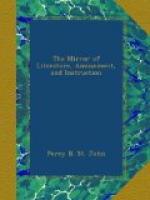NEW WORKS.
* * * * *
MOUNT ARAFAT, AND THE PILGRIMAGE
TO MEKKA.
Every traditionary and topographical particular of this hallowed spot, and the picturesque ceremonies by which it is consecrated, must be acceptable to the Christian reader; and this conviction has induced us to abridge the following from that portion of Burckhardt’s Travels which describes the Hadj, or pilgrimage to Mekka.
At sunrise on the 9th of Zul Hadj, every pilgrim issued from his tent, to walk over the plains, and take a view of the busy crowds assembled there. Long streets of tents, fitted up as bazars, furnished all kinds of provisions. The Syrian and Egyptian cavalry were exercised by their chiefs early in the morning, while thousands of camels were seen feeding upon the dry shrubs of the plain all round the camp. I walked to Mount Arafat, to enjoy from its summit a more distinct view of the whole. This granite hill, which is also called Djebel er’ Rahme, or the Mountain of Mercy, rises on the north-east side of the plain, close to the mountains which encompass it, but separated from them by a rocky valley; it is about a mile, or a mile and a half in circuit; its sides are sloping, and its summit is nearly two hundred feet above the level of the plain. On the eastern side broad stone steps lead up to the top, and a broad unpaved path, on the western, over rude masses of granite, with which its declivity is covered. After mounting about forty steps, we find a spot a little on the left, called Modaa Seydna Adam, or the place of prayer of our Lord Adam, where, it is related, that the father of mankind used to stand while praying; for here it was, according to Mohammedan tradition, that the angel Gabriel first instructed Adam how to adore his Creator. A marble slab, bearing an inscription in modern characters, is fixed in the side of the mountain. On reaching about the sixtieth step, we come to a small paved platform to our right, on a level spot of the hill, where the preacher stands who admonishes the pilgrims on the afternoon of this day, as I shall hereafter mention. Thus high, the steps are so broad and easy that a horse or camel may ascend; but higher up they become more steep and uneven. On the summit, the place is shown where Mohammed used to take his station during the Hadj; a small chapel formerly stood over it; but this was destroyed by the Wahabys: here the pilgrims usually pray two rikats, in salutation of Arafat. The steps and the summit are covered with handkerchiefs to receive their pious gifts, and each family of the Mekkawys or Bedouins of the tribe of Koreysh, in whose territory Arafat lies, has its particular spot assigned to it for this purpose. The summit commands a very extensive and singular prospect. I brought my compass to take a circle of bearings; but the crowd was so great that I could not use it. Towards the western extremity of




